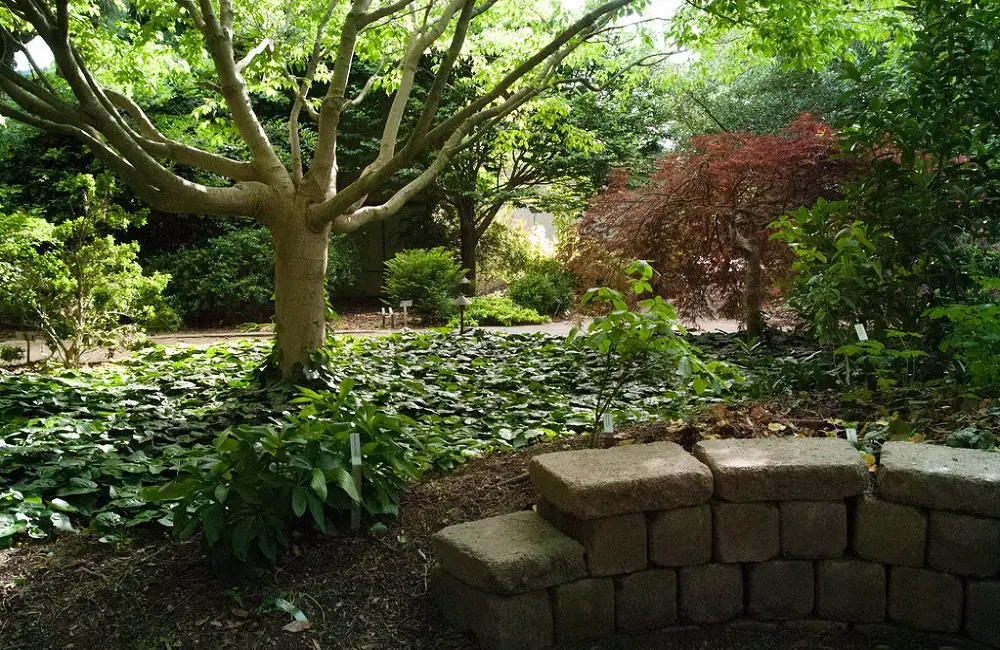Here are some ideas for a shade garden design layout so you may build a shade garden in your backyard that you can enjoy all summer long!
It’s not necessary to have direct sunlight in your backyard to have a lovely garden. As a matter of fact, shaded gardens can sometimes be the most exquisite.
Enjoying a glass of wine at the end of the day or a cup of coffee in the morning is ideal in shade gardens, which may be quite serene and lovely.
In order to assist you in creating a shade garden in your backyard, we will be looking at some shade garden design layout ideas today.
Plant a Tree

Planting a tree can transform your garden by adding a striking focal point and vertical interest. Trees not only enhance the visual appeal with their height and structure but also provide a sense of permanence. If you have an existing mature tree, consider designing a shade garden beneath it to maximize the space and introduce more layers of visual intrigue.
Don’t Forget the Water
Shade-loving plants like ferns and hostas thrive in humid conditions, but even if your climate is humid, your garden might still need extra watering. On average, plants require about 1 inch of water per week, and those in low-lying areas may need more. Utilize a rain gauge to monitor water levels and adjust with a soaker hose or sprinkler as necessary. Watering in the early morning helps plants dry off before nightfall, reducing the risk of disease.
Mix and Match

Shade gardening allows for creative experimentation with various plant types. Combine an assortment of flowers, shrubs, and trees to achieve a dynamic and multi-layered garden. By integrating plants with different heights and growth habits, you can create a garden that feels more organic and less like a conventional flower bed. This approach not only brings seasonal color but also fosters a more complex and vibrant ecosystem.
Create a Secret Garden

If your garden space allows, think about establishing a secret garden—a secluded, intimate area enclosed by fences or hedges. Enhance this private retreat with a gate or archway to signify the entrance. Populate this serene space with shade-loving plants to create a peaceful sanctuary that adds a layer of enchantment to your garden.
Use Containers

Containers offer a versatile solution for growing sun-loving plants in shady areas. By using containers, you can move plants around to capture sunlight and experiment with different garden layouts. Opt for larger containers to ensure more stable soil temperatures, as smaller ones can quickly overheat.
Add a Pop of Color

Injecting color into a shade garden is achievable with a few well-placed plants. While many plants thrive in shade, potted plants and colorful flowers can add vibrant accents. Consider using bright-colored flowers in hanging pots or adding colorful details to garden furniture to introduce lively hues into an otherwise green and neutral space.
Grow a Living Wall

A living wall can be a fantastic solution for small gardens or those needing additional privacy. This green structure is perfect for urban gardens where space is limited. Select shade-loving plants such as ferns and hostas for your living wall and include climbing vines or shade-tolerant annuals to add variety and depth.
Keep It Low-Maintenance

Shade gardens typically require less upkeep compared to sunny gardens. The combination of natural mulch and reduced light means less frequent watering, weeding, and deadheading. Planting in the spring gives plants time to establish before the heat of summer, simplifying maintenance throughout the growing season.
Add a Walkway

Incorporating a walkway can enhance both the functionality and aesthetics of your garden. Walkways can be made from a range of materials like gravel, stepping stones, wood chips, or mulch. Choose a material that aligns with your garden’s style and complements other elements in your landscape.
Don’t Be Afraid to Go Big

Even in a small garden, incorporating larger plants can provide structure and a focal point. Using a substantial plant, such as a large Japanese maple, as a centerpiece around which smaller plants are arranged can create a cohesive and striking garden design. Combining different textures and colors with the larger plant will result in a well-rounded and visually engaging space.

